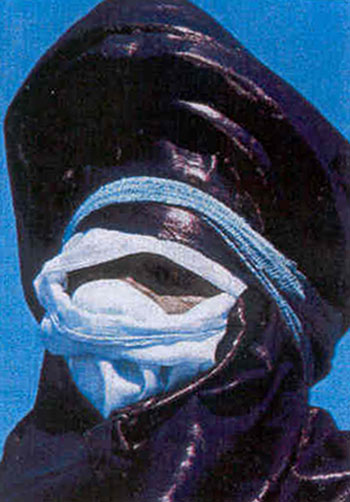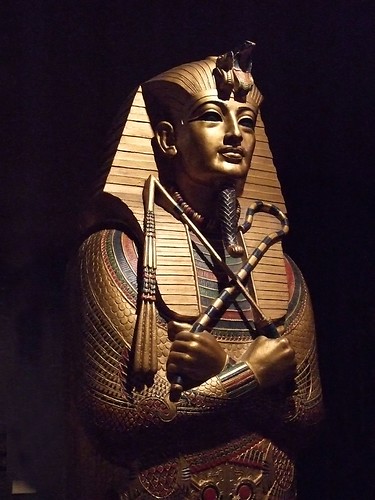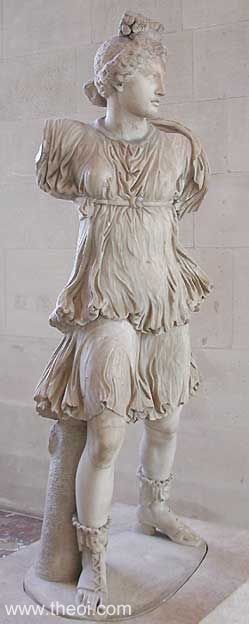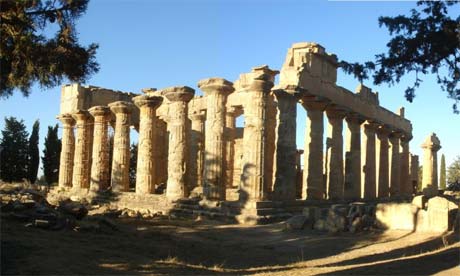
"The Tuareg of northeastern
Africa present an apparition. Suddenly you see: a billowy and shimmery intimidating vision; ripplings of cloth; glints of bladed weapons, slender leaf-thin spears, silver-studded daggers; calmly watching eyes. What you don't see is whole faces. Among the Tuareg it's the men, not the women, who go veiled. Hardened Tuareg warriors, knowing with precision how fabulous they look, arise out of the desert on their tall, swift cloud-white camels looking arrogant and elegant and dangerous and blue.
|  Gallery
'The Art of Being Tuareg'
An exhibition at the National Museum of African Art looks at the culture of the Tuareg people, a semi-nomadic group from West Africa.
|
In "Art of Being Tuareg: Sahara Nomads in a Modern World" at the National Museum of African Art you get to meet the modern Tuareg, who aren't all that modern.
The Tuareg who inhabit parts of Algeria, Libya, Burkina Faso, Mali and Niger are sometimes called by travelers the "Blue Men" of the Sahara. The blue that stains their skin comes from the dark indigo that dyes the tagulmust -- the 15-foot-long cloth, part turban and part veil, that the best-dressed Tuareg noblemen still wrap around their heads.
Their tent poles look like the standards borne by the Roman legions. The patterns of their amulets have antecedents in Carthage. The Cross of Agadez, the chief emblem of the Tuareg, appears to be descended from the ankh of ancient Egypt. There are marks on Tuareg bracelets that are identical to those seen in Libyan inscriptions of the 2nd century B.C.
Most Tuareg men are lean. Their movements, by intent, suggest both elegance and arrogance. Their leanness isn't seen as much as it's suggested by the way their loose and flowing robes move about their limbs.
All in all, the Tuareg don't look much like Parisians. When 19th-century French imperialists first came upon the Tuareg in the wastes of the Sahara, they reacted as they might have when meeting men from Mars.
The Tuareg were, to French eyes, menacing, imposing, alien and exotic. Their beauty was undeniable, as was their ferocity (it took more than 20 years before imperialist French armies felt confident in entering traditional Tuareg lands), as was their ability to navigate the desert. The Tuareg didn't just raid French colonialists. They raided each other. Sometimes 20,000 camels would be gathered for the long and risky Tuareg-guarded caravans that carried loads of salt south to Timbuktu.
It is still easy to see why the beauty of the Tuareg, and other desert peoples, sent a shiver through French art, tinting with strange hues the otherworldly Orientalism of painters as diverse as Eug¿ne Delacroix, Jean-Leon Gerome and Henri Matisse.
The African Museum's thoughtful exhibition -- a joint product of the Iris & B. Gerald Cantor Center for Visual Arts at Stanford University and the Fowler Museum at UCLA -- is far too self-aware to indulge in overcooked stereotypical Orientalism. But its leather bags and hand-forged swords, its camel saddles and sugar shears, share this with the ripe paintings of Delacroix and Matisse. Both intentionally conflate, as does most of Tuareg art, the wholly up-to-date with the very old indeed.
The Tuareg's written language, Tifnar, also points one toward antiquity. Modern is what it isn't. Tifnar can be written vertically or horizontally, and from left to right or from right to left. Its script is composed of lines and dots and circles. Its characters are shared with the cuneiforms of Babylon and the alphabet of the Phoenicians.
Judaism, too, has a place in Tuareg art, almost all of which is made by a people called the inadan -- an admired and despised class of Tuareg artisans (and diplomats, censors, clowns and spies) who believe themselves related to the House of David, and are thought to be descended from enslaved Moroccan Jews.
Tuareg nobles rule by right. Commanding is their duty, as is guarding family honor -- always showing, through their bearing, proper dignity and reserve. Unlike the inadan beneath them, they don't soil themselves with soot, or muck about with blacksmithing, or produce things to use.
"The blacksmith," observed one Tuareg informant in the 1940s, "is always a born traitor; he's fit to do anything. . . . His mendacity is proverbial; moreover it would be dangerous to offend him, for he is skillful at satire and if need be will spout couplets of his own devising about anyone who brushes him off; thus, no one wishes to risk his taunts. In return for this, no one is as ill-esteemed as the blacksmith."
The disdain is almost palpable. It feels ancient, too."
If you enjoyed this post, never miss out on future posts by following me by email!




























